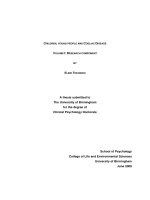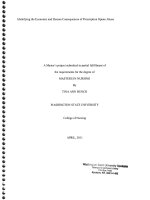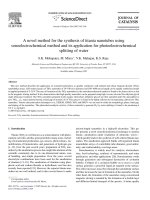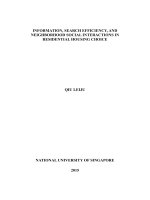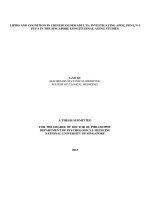A THESIS SUBMITTED FOR THE DEGREE OF DOCTOR OF PHILOSOPHY
Bạn đang xem bản rút gọn của tài liệu. Xem và tải ngay bản đầy đủ của tài liệu tại đây (8.21 MB, 202 trang )
ANALYSIS OF RGA-LIKE 2 (RGL2), A GIBBERELLIC
ACID RESPONSE REGULATOR, IN THE FLOWER
DEVELOPMENT OF ARABIDOPSIS
THALIANA
TAN EE LING
(B.Sc. HONS, NUS)
A THESIS SUBMITTED
FOR THE DEGREE OF DOCTOR OF PHILOSOPHY
DEPARTMENT OF BIOLOGICAL SCIENCES
NATIONAL UNIVERSITY OF SINGAPORE
2007
ii
ACKNOWLEDGEMENTS
This stint in research has truly been an eye-opener. It has exposed me to
various cultures through the relationships I have developed with people from different
countries. It has also taught me patience and perseverance in honing my research
skills, as well as developing thinking skills in a more systematic manner.
Firstly, I would like to give my sincere and grateful thanks to my main
supervisor, Associate Professor Prakash Kumar, for his guidance, advice and
supervision throughout my years of research, ever since I started out research as a
wee honors student in his Plant Morphogenesis lab.
I also greatly appreciate the ideas and advice of my co-supervisor, Assistant
Professor Yu Hao, who was always ready to listen and help in troubleshooting. I also
thank him for imparting valuable techniques and skills relevant to my research.
I am thankful to my thesis committee advisors, Associate Professors Sanjay
Swarup and Loh Chiang Shiong, for their invaluable advice, encouragement and
ideas.
I would like to acknowledge the National University of Singapore for
providing the research scholarship that made this research stint possible.
I wish to acknowledge Associate Professor Peng Jinrong from the Institute of
Molecular and Cell Biology for providing the starting materials for this research
work. I would also like to thank A/P Peng and Professor Bertrand Seraphin for their
kind permission in allowing me to reproduce some images from their earlier papers.
I am deeply grateful for the technical help from the staff at the Electron
Microscopy Unit. I thank Mdm Loy Gek Luan for her kindness and technical
assistance in the SEM work. I also sincerely appreciate the patience and help from Mr
Loh Mun Seng for teaching me how to perform and improve on sectioning
iii
techniques. I am also truly grateful to Mr Chong Ping Lee who never hesitated to help
me and promptly responded to my email queries whenever I encountered technical
problems with plant growth chambers. I would also like to give my thanks to Mrs
Ang-Lim Swee Eng for helping me source temporary space to grow my plants and
help in getting photography equipment. I thank Mr Yan Tie and Ms Kho Say Tin for
assistance in photo imaging and mass spectrophotometry, respectively.
I give my deepest appreciation to my lab mates who inculcated a warm lab
environment that made carrying out research work in a lab, interesting, fun and
stimulating. Firstly, I wish to say a big thank you to my lab colleagues, Lianlian and
Jaclyn, who provided a fun and estrogen-loaded lab environment. I thank the both of
them for constantly supplying and ensuring there was food present for me, which was
crucial to satisfying my hunger pangs during lab work. I give my sincere thanks to
Yifeng who helped me troubleshoot experiments and shared his techniques in
research work. I thank Mandar for his useful discussions on protein experiments. I
like to say a big thanks to Edwin for cerebral discussions during tea breaks. I am also
deeply appreciative to Yuhfen, Serena, Carol, Weekee, Dileep, Liu Chang, Lailai,
Wangyu and Sulee who have helped me in one task or another.
I am indebted to my husband, Chico, for his wonderful improvised ideas and
unwavering support in whatever I do. I am tremendously thankful for his help in some
technical aspects of my work, and for being my constant pillar of strength.
Lastly, I am truly grateful and immensely appreciative to my family for their
constant support, love, encouragement (with a bit of nagging thrown in) and
understanding in whatever I do, that made all things possible.
iv
TABLE OF CONTENTS
ACKNOWLEDGEMENTS i
TABLE OF CONTENTS iv
SUMMARY vii
LIST OF TABLES ix
LIST OF FIGURES x
LIST OF ABBREVIATIONS xiii
CHAPTER 1 1
GENERAL INTRODUCTION 1
CHAPTER 2 5
LITERATURE REVIEW 5
2.1 Introduction 5
2.2 Regulation of gibberellins in plants 6
2.2.1 The gibberellin biosynthesis pathway 6
2.2.2 The gibberellin signaling pathway and its regulatory proteins 10
2.3 A soluble receptor for gibberellin is finally characterized 14
2.4 The GRAS superfamily of putative transcription factors and DELLA
proteins 15
2.5 RGL genes and their implications in plant development 16
2.6 Characterization of RGL genes 17
2.7 RGL2 and seed germination 20
2.8 DELLA proteins are important integrators of multiple phytohormone
signaling pathways 22
2.9 The ubiquitin 26S proteasome pathway is involved in the degradation of
DELLA proteins 24
2.10 The DELLA proteins ‘relief of restraint’ model 26
2.11 The postulated model on GA signaling pathway and potential interactions
among the DELLA proteins 28
2.12 Various strategies to isolate potential downstream genes and interacting
coeffectors of RGL2 31
2.12.1 The Glucocorticoid Receptor (GR) domain tag – an inducible gene
expression system 31
2.12.2 The Tandem Affinity Purification tag (TAP™ tag) system for isolation
of interacting factors 34
2.12.3 A rapid one-step protein purification system in plants using a StrepII
tag 37
CHAPTER 3 40
ANALYSIS OF RGL2 EXPRESSION DURING FLORAL TRANSITION AND
DIFFERENT STAGES OF FLOWER DEVELOPMENT IN ARABIDOPSIS 40
3.1 Introduction 40
3.2 Materials and methods 40
3.2.1 Plant materials and growth conditions 40
3.2.2 GUS histological analysis 41
v
3.2.2.1 Tissue fixation and staining………………………………….41
3.2.2.2 Dehydration………………………………………………….41
3.2.2.3 Clearing………………………………………………………42
3.2.2.4 Infiltration……………………………………………………42
3.2.2.5 Embedding and sectioning………………………………… 42
3.2.2.6 Deparaffination and rehydration…………………………… 43
3.2.3 In situ hybridization 43
3.2.3.1 Probe preparation…………………………………………….43
3.2.3.2 Carbonate hydrolysis…………………………………………44
3.2.3.3 Fixation………………………………………………………45
3.2.3.4 Dehydration………………………………………………….45
3.2.3.5 In situ section pre-treatment…………………………………46
3.2.3.6 In situ hybridization………………………………………….46
3.2.3.7 Post hybridization washing and detection………………… 47
3.3 Results 48
3.3.1 GUS histological analysis of rgl2-5 floral tissues 48
3.3.2 In situ hybridization analyses of wild-type Arabidopsis floral tissues 48
3.4 Discussion 52
CHAPTER 4 57
CONSTITUTIVE AND CONDITIONAL OVEREXPRESSION OF RGL2 IN
ARABIDOPSIS 57
4.1 Introduction 57
4.2 Materials and methods 57
4.2.1 Plant growth and conditions 57
4.2.2 Bacterial strains and plasmids 57
4.2.3 Plant genomic DNA extraction 58
4.2.4 Isolation of full-length RGL2 cDNA by PCR 61
4.2.5 Cloning of the full-length RGL2 cDNA 63
4.2.6 Preparation of E. coli competent cells for heat-shock transformation.64
4.2.7 Transformation of E. coli competent cells 66
4.2.8 Screening of clones containing the desired fragments 66
4.2.9 DNA sequencing and analysis 68
4.2.10 Manipulation of the modified pGreen vectors 69
4.2.11 Cloning full-length RGL2 gene into modified pGreen binary vector 70
4.2.12 Cloning full-length RGL2 gene into modified pGreen-GR binary
vector 72
4.2.13 Preparation of Agrobacterium tumefaciens competent cells for
transformation 72
4.2.14 Electroporation of Agrobacterium tumefaciens 74
4.2.15 Agrobacterium-mediated transformation of Arabidopsis by floral dip75
4.2.16 Quick DNA preparation using Shorty buffer 76
4.2.17 Genetic analysis and characterization of the transformants 77
4.2.18 Extraction of total RNA from Arabidopsis 77
4.2.19 First-strand cDNA synthesis for Reverse-Transcription Polymerase
Chain Reaction (RT-PCR) 79
4.2.20 Expression analysis of transgenic overexpression lines 79
4.2.21 Scanning electron microscopy 80
4.2.22 Steroid hormone treatment of transgenic Arabidopsis plants 80
4.3 Results 81
vi
4.3.1 Cloning full-length RGL2 into modified pGreen vectors 81
4.3.2 Genomic DNA screening of transgenic Arabidopsis plants 86
4.3.3 Phenotypic analyses of transgenic Arabidopsis plants 90
4.3.4 Analysis of floral tissues of transgenic lines using Scanning Electron
Microscopy 93
4.3.5 Conditional analysis of steroid hormone treated transgenic plants 96
4.4 Discussion 98
CHAPTER 5 102
INVESTIGATION OF POTENTIAL RELATIONSHIPS AMONG RGL2,
FLORAL ORGAN IDENTITY GENES AND DELLA GENE FAMILY
MEMBERS 102
5.1 Introduction 102
5.2 Materials and methods 104
5.2.1 Plant materials and growth conditions 104
5.2.2 Agrobacterium-mediated plant transformation 104
5.2.3 Characterization of transgenic plants 104
5.2.4 Steroid hormone treatment of transgenic mutant plants 104
5.2.5 Expression analyses of different floral organ identity genes in the rgl2
mutant background 105
5.2.6 Cloning full-length RGL2 into pGreen-TAP binary vector 106
5.2.7 Cloning full-length RGL2 into pGreen-GR-TAP binary vector……106
5.2.8 Cloning full-length RGL2 into pGreen-StrepII binary vector 108
5.2.9 Characterization of transgenic plants carrying the fusion constructs 110
5.2.10 Extraction of proteins from transgenic lines 112
5.2.10.1 Purification via StrepII tag………………………………….112
5.2.10.2 Sodium Dodecyl Sulfate-Polyacrylamide Gel Electrophoresis
(SDS- PAGE)……………………………………………….114
5.2.10.3 Silver staining of polyacrylamide gels…………………… 114
5.2.10.4 Western blot analysis……………………………………….117
5.3 Results 118
5.3.1 Characterization of ga1-3 rga rgl2 RGL2::GR transgenic plants 118
5.3.2 Effect of RGL2 on the floral organ identity genes analyzed using the
steroid inducible system 126
5.3.3 Characterization of transgenic plants and effectiveness of various
protein tagging approaches – TAP™ tag 130
5.3.4 Characterization of transgenic plants and effectiveness of another
protein tagging approach – StrepII tag 137
5.4 Discussion 146
GENERAL CONCLUSIONS AND FUTURE PERSPECTIVES 156
REFERENCES 158
APPENDICES I
vii
SUMMARY
In this study, the role of a G
ibberellic Acid (GA) regulator named RGA-Like
2 (RGL2) in Arabidopsis thaliana flower development was analyzed using molecular
genetics approaches. The GA signaling components and their interactions with one
another, as well as crosstalk with other phytohormone signaling components, have
only been discovered recently. The functions of a small group of transcriptional
regulators found in GA signaling of Arabidopsis, called the DELLA proteins, named
for their distinctive five amino acids domain, have been recently analyzed. The first
two DELLA proteins, RGA (R
epressor of GA1) and GAI (Gibberellic Acid
Insensitive), were characterized as negative regulators of the GA signaling pathway.
The remaining three DELLA proteins called RGL proteins were later found to have
effects on seed germination (RGL1 and RGL2) with the exception of RGL3, which
has not been characterized yet. So far, the GA signaling pathway involving these
proteins and their interacting factors are not clear. This study focused on the potential
role of RGL2 in floral development, as the combination of RGA and RGL2 has shown
effects on floral development (Cheng et al., 2004; Yu et al., 2004). Using GUS
staining and in situ hybridization techniques, the spatial expression of RGL2 in floral
development was examined. It was found that RGL2 was expressed in floral
primordia from stage 1 to stage 7 of floral development. Furthermore, RGL2 was also
expressed in the placenta of the carpel, at the base of the stigma, and in the style,
filaments and petals. A prior study had shown that RGL2 was a negative regulator of
seed germination in loss-of-function experiments. By generating overexpression
transgenic lines and transgenic lines possessing a fusion protein with a steroid
hormone-inducible gene expression system, the function of RGL2 in flower
development was further examined. Although overexpression of RGL2 in wild-type
viii
Arabidopsis did not produce substantial aberrations or major phenotypic changes in
the floral tissues, its overexpression in ga1-3 rga rgl2 caused obvious floral defects,
indicating that RGL2 is a negative regulator of flower development. Last but not
least, the final objective was to identify potential interacting co-effectors of RGL2, as
it was classified as a putative transcriptional regulator as other DELLA proteins.
Using a controlled gene inducible expression system, the translocation of RGL2 into
the nucleus led to potential downregulation of AP2, a Class A floral organ identity
gene. Other floral organ identity genes were not substantially affected. Various
protein tagging strategies were also employed to isolate possible co-effectors of
RGL2, which could have modified RGL2 activity, and thus affected RGL2 regulation
of target genes. After trial and error attempts on experimenting with the various tags,
we found that the TAP™ tagging strategy was not feasible with RGL2, as it hindered
its biological function. Instead, the StrepII tag was successfully utilized. Amino acid
sequencing of proteins pulled-down with the tagged RGL2 revealed that a potential
kinase or serine/threonine protein kinase could be an interacting factor with RGL2.
This is a potential co-effector of RGL2 as RGL2 has a GA-response specific domain
(DELLA domain), which has a poly serine/threonine string of residues in the N-
terminal region. This region could be targeted by the putative kinase for
phosphorylation.
ix
LIST OF TABLES
Table 4.1. List of primers used in experiments mentioned in Chapters 4 and 5 62
Table 4.2. Culture media, antibiotics and chemicals used for growing bacteria. 65
Table 5.1. Components used in SDS-PAGE 115
Table 5.2. Reagents and chemicals used for SDS-PAGE 116
Table 5.3. Preparation of SDS gel – loading buffer 116
Table 5.4. Reagents and chemicals used in Western blotting 119
Table 5.5. Changes in gene expression level of floral organ identity after mock and
dexamethasone treatment on floral tissues of ga1-3 rga rgl2 RGL2::GR.
129
x
LIST OF FIGURES
Figure 2.1. Model showing the homeostatic regulation of GA biosynthesis 8
Figure 2.2. Comparison in phenotype between an Arabidopsis wild-type plant (left
panel, red arrow) and a ga1-3 GA biosynthesis mutant (right panel). Both
plants were photographed 3 weeks after germination. (Scale bars = 1 cm) 9
Figure 2.3. Amino acid sequence alignment of the predicted DELLA proteins 18
Figure 2.4. The DELLA subfamily of the GRAS regulatory proteins 19
Figure 2.5. The ‘relief of restraint’ model. ………………………………………… 27
Figure 2.6. Postulated model of GA signaling in Arabidopsis. 30
Figure 2.7. The mechanism of the steroid inducible activation system 33
Figure 2.8. Overview of the TAP™ tag purification strategy. 35
Figure 2.9. An overview of the StrepII tag affinity purification strategy. ………… 39
Figure 3.1. GUS histological analysis of rgl2-5 showing staining in connective tissue
and stamens 49
Figure 3.2. GUS histological analysis of rgl2-5 showing stainings in petals and
stigma 50
Figure 3.3. GUS histological analysis of rgl2-5 showing staining in the carpel. 51
Figure 3.4. In situ hybridization of wild-type Arabidopsis inflorescence apex 53
Figure 3.5. In situ hybridization of floral meristems from wild-type Arabidopsis 54
Figure 3.6. In situ hybridization on the cross sections of the wild-type floral buds
(ecotype Landsberg erecta). 55
Figure 4.1. The binary vector pGreen-HY102 35S::GR::TAP. 59
Figure 4.2. The binary vector pGreen-HY103 35S::TAP 60
xi
Figure 4.3. The completed construct pGreen-HY103 (modified) 35S::RGL2. 71
Figure 4.4. The completed construct pGreen-HY102 (modified) 35S::RGL2::GR. 73
Figure 4.5. Expected band sizes of RGL2 and GR in PCR amplification 82
Figure 4.6. RGL2 was cloned into pGEM
®
-T Easy vector as an intermediate step. 84
Figure 4.7. Excision of TAP from the pGreen GR-TAP vector backbone. 85
Figure 4.8. PCR amplification results of RGL2 clones 87
Figure 4.9. PCR screening of overexpression transgenic lines 35S::RGL2. 89
Figure 4.10. PCR screening of 35S::RGL2::GR overexpression lines 91
Figure 4.11. Phenotypes of 35S::RGL2 overexpression lines. 92
Figure 4.12. Phenotypes of 35S::RGL2::GR transgenic lines. 94
Figure 4.13. SEM images of sepal cells from transgenic overexpression lines 95
Figure 4.14. RGL2 expression in constitutive and conditional overexpression lines. .97
Figure 5.1. The completed construct pGreen-HY103 35S::RGL2::TAP 107
Figure 5.2. The completed construct pGreen-HY102 35S::RGL2::GR::TAP 109
Figure 5.3. The completed construct pGreen-LC101 35S::RGL2::StrepII. 111
Figure 5.4. The triple mutant ga1-3 rga rgl2 120
Figure 5.5. Analyses of RGL2 expression in ga1-3 rga rgl2 transgenic plants 122
Figure 5.6. First optimization of application of dexamethasone. 123
Figure 5.7. Independent ga1-3 rga rgl2 transgenic line showing strong
complementation of RGL2::GR 124
Figure 5.8. Overall view of complementation analyses 125
Figure 5.9. Time course expression of floral organ identity genes after induction of
RGL2 expression. 128
Figure 5.10. PCR screening of RGL2::GR::TAP transgenic lines. 131
xii
Figure 5.11.Floral tissues of independent transgenic lines of ga1-3 rga rgl2
RGL2::GR::TAP. 133
Figure 5.12. Phenotypes of ga1-3 rga rgl2 RGL2::GR::TAP transgenic lines treated
with dexamethasone 135
Figure 5.13. PCR screening of transgenic lines expressing RGL2::TAP 136
Figure 5.14. Phenotypes of overexpression of RGL2::TAP in different backgrounds.
138
Figure 5.15. Verification of 35S::RGL2::StrepII construct and protein function 140
Figure 5.16. Silver-stained acrylamide gel of protein samples after purification 143
Figure 5.17. Screenshots of MS sequencing results. 145
xiii
LIST OF ABBREVIATIONS
Chemicals and reagents
AEBSF 4-(2-aminoethyl)benzenesulfonyl fluoride hydrochloride
APS ammonium persulphate
BCIP 5-bromo-4-chloro-3-indolyl phosphate, toluidine salt
DEPC diethylpyrocarbonate
dNTP deoxyribonucleic acid triphosphate
DTT dithiothreitol
EDTA ethylenediaminetetraacetic acid
EGTA ethylene glycol-bis[β-aminoethyl ether]-N, N, N’N’-tetraacetic acid
GA gibberellic acid
IPTG isopropyl-1-thio-β-D-galactopyranoside
NBT 4-nitro blue tetrazolium chloride
PBS phosphate buffered saline
SDS sodium dodecyl sulfate
SSC standard saline citrate
TBA tert-butanol
TBS Tris buffered saline
TE Tris-EDTA
TEMED N, N, N’N’ - tetramethylethylenediamine
Tris Tris(hydromethyl)-aminomethane
X-GAL 5-bromo-4-chloro-3-indolyl-β-galactopyranoside
xiv
Units and measurements
bp base pairs
ºC degrees Celsius
g gram(s) or gravitational force, according to the intended meaning
h hour
kb kilo base pair
kDa kilo Dalton
kV kilovolt
l liter
M mole per liter
mg milligram
min minute
ml milliliter
mM millimolar
ng nanogram
rpm revolutions per minute
s second
U Unit
μl microliter
μg microgram
μM micromole
μm micrometer
v/v volume to volume
w/v weight to volume
xv
Enzymes
DNase deoxyribonuclease
GUS β-glucuronidase
RNase ribonuclease
Others
CaMV cauliflower mosaic virus
cDNA complementary deoxyribonucleic acid
DNA deoxyribonucleic acid
mRNA messenger ribonucleic acid
RNA ribonucleic acid
oligo-dT oligodeoxythymidylic acid
PCR polymerase chain reaction
RT reverse-transcription
T-DNA transfer of DNA
1
CHAPTER 1
GENERAL INTRODUCTION
Growth and development of plants are subjected to many intrinsic and
extrinsic influences. Plant hormones, in particular, are crucial and vital to the survival
of plants. These hormones are involved in many stages throughout the life cycle of
plants. Gibberellic Acids (GAs), or gibberellins, are one such important class of plant
hormones. They are involved in many aspects of plant development, including seed
germination, hypocotyl elongation, floral induction, leaf expansion, apical dominance,
floral development, fruit maturation and internode elongation.
Like all plant hormones, the influence of gibberellins on growth regulation is
controlled in two ways. The first one is by controlling the quantity of available GA by
modifying the biosynthesis and metabolism. The second pathway of regulation is by
altering the perception and signal transduction of active GA. Early research on
mutants defective in GA biosynthesis revealed the developmental role of gibberellins.
An important GA-deficient biosynthesis mutant used for this project is the ga1-3
mutant (Koornneef and van der Veen, 1980). This mutant has a deletion of a gene
GA1 that encodes ent-CDP synthase, which is a crucial enzyme that is involved in GA
biosynthesis. The mutant phenotype of ga1-3 is severe. Compared to the wild-type
Arabidopsis, ga1-3 shows dwarfed and bushier statures (because of the reduced apical
dominance), darker green leaves, delayed flowering in short days, and retarded
growth of floral organs, especially the male organ, stamens (Koornneef and van der
Veen, 1980).
Investigation of GA signal transduction mutants has revealed three important
players in GA signaling. The first, spy (spindly), is a recessive GA-constitutive-
2
response slender mutant. The corresponding gene is a negative regulator of stem
elongation and mutations in this gene results in early flowering and stem elongation
(Jacobsen and Olszewski, 1993). The next important GA signaling mutant, gai
(gibberellic acid insensitive), is a dwarf mutant, which was impaired in a regulator
that has orthologs in wheat and maize (Peng and Harberd, 1993). The last mutant that
will be often mentioned is rga (repressor of ga1-3). The corresponding gene has been
characterized as a transcriptional regulator that represses GA signaling (Silverstone et
al., 1997b).
The latter two GA signaling mutants are members of the GRAS (G
AI, RGA
and SCARECROW) family of regulatory proteins. These proteins are unique only to
plants and are involved in many aspects of plant development. Currently, there are 38
known Arabidopsis GRAS family members and all contain a conserved central region
and a C-terminal region in their protein sequences. The diversity lies in the acidic N-
terminal region. Within this large family of transcriptional regulators, there lies a
small subfamily of GRAS regulatory proteins called the DELLA subfamily, which
includes RGA and GAI that have a unique conserved DELLA domain at the N-
terminus (D – aspartic acid; E – glutamic acid; L – leucine; A – alanine) (Richards et
al., 2001). It was found that a 17 amino acid deletion in this domain causes a GA-
insensitive dwarf phenotype. This was important for the inactivation of RGA and GAI
by the GA signal. Functional orthologs of RGA and GAI were also isolated from
economically important food crops. Thus the DELLA genes were deemed important
in agriculture, especially during the era of the ‘Green Revolution’ (Peng et al.,
1999b).
In a previous study, loss of function mutants, rga and gai, could not,
individually or in combination, rescue the germination and floral development defects
3
of ga1-3 in the absence of exogenous GA (Dill and Sun, 2001). It was hypothesized
that additional genes or signaling components were necessary in modulating these two
aspects of plant development in GA signaling. Previous studies have also revealed
that apart from RGA and GAI, the other DELLA members were RGA-Like 1 (RGL1),
RGA-Like 2 (RGL2) and RGA-Like 3 (RGL3). These 5 DELLA gene family members
possess two highly conserved N-terminal regions containing the DELLA and VHYNP
amino acid domains, which are however, absent in the other GRAS family members.
The two domains are critical for GA signaling, based on research data from the gai
mutant and other rga/gai orthologs in wheat and maize (Olszewski et al., 2002). The 5
DELLA genes also possess high sequence similarity in the C-terminal regions in their
gene structure.
Thus, it was postulated by Lee et al. (2002) that the RGL genes, which shared
high homology with RGA and GAI, could be implicated in seed germination and
flower development. The specific role of RGL2 in flower development had not been
fully understood and may have functional redundancy, due to the high homology
shared among these RGL genes.
The following progress revealed that the DELLA proteins are important in
flower development and seed germination. Recently, it was found that in the GA
signaling pathway, DELLA proteins regulated floral homeotic genes in flower
development (Yu et al., 2004). Synergistic effects of DELLA proteins in flower
development and seed germination in Arabidopsis were also observed (Tyler et al.,
2004). Loss of function of RGA, GAI, RGL2 and RGL1 DELLA genes led to light-
and gibberellin-independent seed germination in Arabidopsis (Cao et al., 2005). Most
importantly, a GA receptor was recently isolated from rice. A GA-insensitive dwarf
mutant of rice named gid1, was identified due to loss of function of a soluble receptor
4
mediating GA signaling (Ueguchi-Tanaka et al., 2005). With these findings in
consideration, the following objectives were proposed.
The main research objectives in this project were:
1. to analyze RGL2 expression during floral transition and different stages of
flower development in Arabidopsis.
2. to study the constitutive and conditional overexpression of RGL2 in
Arabidopsis
3. to investigate potential relationships among RGL2, floral organ identity genes
and DELLA gene family members.
This project focussed on studying the effect of RGL2 on floral development using
molecular genetics approaches. This would shed light on how RGL2 may interact
with other DELLA genes to affect the floral organ identity genes, and provide insights
into the understanding of GA signaling pathway in Arabidopsis floral development.
5
CHAPTER 2
LITERATURE REVIEW
2.1 Introduction
All botany students would have learned the importance of the different classes
of plant hormones affecting various aspects of plant development. Gibberellic
acids/gibberellins (GAs) are an important group of plant hormones. It was discovered
as an active compound first isolated from an ascomycete Fusarium species at the
sexual stage, called Gibberella fujikuroi. This was discovered in Japan in the 1930s
where rice farmers noticed that a particular fungal species caused a serious disease in
rice plants. They described the plants afflicted with the disease as bakanae-byo, or
“foolish seedling disease”. The symptoms of these infected plants included excessive
growth in height of the rice seedlings, and a decline in seed production in mature
plants. The active compound, gibberellin, was subsequently discovered and named
after the disease-causing fungus (Eckardt, 2002).
This new class of essential endogenous plant hormones was instrumental in
regulating various aspects of plant development. These include the promotion of seed
germination, leaf expansion, cell elongation, hypocotyl and stem elongation, apical
dominance, regulation of flowering time, fruit maturation and floral development
(Dill and Sun, 2001; Sun 2000; Richards et al., 2001; Harberd et al., 1998).
Gibberellins are a group of tetracyclic diterpenoid carboxylic acids. Only a
few are known to have biological functions even though there are over a hundred
identified gibberellins (Yamaguchi and Kamiya, 2000). Gibberellins are regulated by
the biosynthesis and metabolism pathways, as well as by the perception and
6
transduction of active GA signals. These pathways interact and interlink to ensure that
GAs are regulated at the proper endogenous quantities in plants.
2.2 Regulation of gibberellins in plants
2.2.1 The gibberellin biosynthesis pathway
The biosynthesis of gibberellins is regulated by both endogenous and
environmental signals. The biosynthesis pathway is controlled by three classes of
enzymes namely, terpene cyclases, Cyt P450 monooxygenases, and 2-oxoglutarate-
dependent dioxygenases (Hedden and Kamiya, 1997). These enzymes are involved in
the creation of bioactive GAs in the following process. Diterpenes and carotenoids
have a common precursor that is geranylgeranyl diphosphate (GGDP). This
compound is converted to a tetracyclic hydrocarbon, ent-kaurene, by two terpene
cyclases, copalyl diphosphate synthase (CPS) and ent-kaurene synthase (KS). This
process is carried out in plastids. In the next stage, ent-kaurene is oxidized by Cyt
P450 monooxygenases to form GA
12
-aldehyde, which happens in the endoplasmic
reticulum. In the last stage, GA
12
-aldehyde is converted to bioactive GAs by 2-
oxoglutarate dependent dioxygenases, that are possibly cytosolic enzymes, including
GA 7-oxidase, GA 20-oxidase, GA 3β-hydroxylase, and GA 2-oxidase. The genes
that encode for these GA biosynthesis enzymes were isolated from pumpkin where it
was found that the endosperm from immature pumpkin seeds contained a high
concentration of GA biosynthetic enzymes (Hedden and Kamiya, 1997).
Subsequently, the genes involved in GA biosynthesis were also isolated from
Arabidopsis using molecular genetics approach. The GA1, GA3 and GA4 genes were
7
found to encode for CPS, ent-kaurene oxidase and GA 3β-hydroxylase, respectively,
which are all critical enzymes in the generation of bioactive GAs (Helliwell et al.,
1998). Some of these enzymes can catalyze the same reaction for different, but
structurally similar substrates. E.g., GA 3β-hydroxylase is critical in catalyzing GA
9
to GA
4
, and GA
20
to GA
1
, both end products that are bioactive GAs (Figure 2.1). As
differences in the level of GAs can affect and alter plant development, plants have
evolved a mechanism to control the levels of GAs being synthesized. It seems that
GA levels are controlled by a negative feedback mechanism that affects the amount of
transcripts coding for the GA biosynthesis genes (Harberd et al., 1998).
Silverstone et al. (1997a) has elucidated the role of GA1 in GA developmental
regulation. GA1 codes for the enzyme that is involved in the first committed step in
GA biosynthesis. Arabidopsis GA1 mRNA and protein levels in plant tissues were
extremely low as revealed from the results showing cellular localization of GA1 by
GA1 promoter-GUS reporter gene expression and Reverse Transcription-Polymerase
Chain Reaction (RT-PCR). The promoter activity was limited to specific cell types,
namely, shoot apices, root tips, anthers and immature seeds. This organ/tissue-specific
expression of GA1 correlated to the mutant phenotype of ga1. The ga1-3 is a GA
deficient mutant where the function of GA1 is lost due to a large deletion leading to
dramatic developmental abnormalities. The severe phenotype of ga1-3 include
dwarfism, darker green leaves and bushier stature than wild-type Arabidopsis
(reduced apical dominance), ungerminated seeds, delayed flowering in short days, and
abnormal flowers with retarded growth of floral organs (Figure 2.2). These
phenotypes can be reverted back to wild-type characteristics upon exogenous
application of GA.
8
Figure 2.1. Model showing the homeostatic regulation of GA biosynthesis.
Feedback inhibition is shown by the T-bar. GA 20-oxidase and GA 3β-hydroxylase
transcripts are negatively regulated by GA activity. The arrows indicate feedforward
upregulation. Adapted from Yamaguchi and Kamiya (2000).
GA
12/53
GA
9/20
GA
4/1
(bioactive)
GA receptor
GA response
GA 20-oxidase
and
GA 3β-
hydroxylase
GA
51/29
GA 2-oxidase
GA
34/8
9
Figure 2.2. Comparison in phenotype between an Arabidopsis wild-type plant (left
panel, red arrow) and a ga1-3 GA biosynthesis mutant (right panel). Both plants were
photographed 3 weeks after germination. (Scale bars = 1 cm)
10
Other ga1 mutant alleles possess less dramatic phenotypic aberrations
compared to ga1-3. For instance, ga1-6 mutation results also in a dwarf phenotype
albeit less severe, and can germinate and set seed in the absence of exogenous GA.
The ga1-6 mutation is caused by an amino acid substitution in ent-CDP synthase and
thus reduced enzyme activity. Compared to the ga1-3 mutant, the ga1-6 mutant
contains higher levels of endogenous GA. In this study, ga1-3 is the only GA
biosynthesis mutant used for genetic crossing and other major investigations.
2.2.2 The gibberellin signaling pathway and its regulatory proteins
The well-established studies of mutants’ defective biosynthesis of GAs and
the utilization of biochemical techniques have revealed the developmental role of
GAs. On the other hand, the studies on GA signaling effects are more recent. The
perception and transduction of active GA signals to different locations in plants
explain how the synthesized GAs, coupled with the GA signaling pathway, control
GA-response gene expression to affect plant development. The first model used to
study the GA response genes was the cereal aleurone (Lovegrove et al., 2000). The
expression of α-amylase gene, the most abundant hydrolase found in the aleurone
layer, was directly induced by GA, which was used as an indicator for measuring the
GA response in this tissue. GA-response mutants are classified into two groups. The
first phenotypic category comprises the elongated slender mutants that have longer
petioles, paler green leaves, taller stems and lower fertility as compared to wild-type
plants. This kind of phenotype is similar to wild-type plants being excessively treated
with a high dose of GA. The second category is the GA unresponsive dwarf mutants
that look similar to the GA biosynthesis mutants, except that the defects are not
